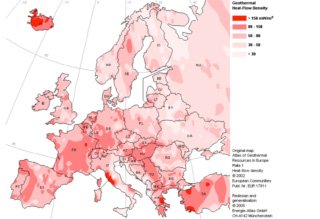The energy price assessment performed in the document “D4.1 – Energy Price Assessment” provides a comprehensive review of the main heat production systems and primary energy sources associated with District Heating systems in Europe.

Geothermal heat flow density in Europe. EC 2012. © EC, 2012.
District heating (DH) systems are one of the most energy efficient heating systems in urban environments and they are also key systems in the de-carbonization of heating energy in European Cities.
Renewable and waste heat sources are foreseen at the same time as de-carbonized heat sources and the way to guarantee competitive energy costs with limited influence of fossil fuel supply price volatility. To achieve this, conversion of DHs is needed.
RELaTED will provide an innovative concept of decentralized Ultra-Low Temperature (ULT) DH networks, which allow for the incorporation of low-grade heat sources with minimal constraints. Also, ULT DH reduce operational costs due to fewer heat losses, better energy performance of heat generation plants and extensive use of de-carbonized energy sources at low marginal costs.
Economic viability of ULT DH systems
In this context, it is of vital importance to ensure the economic viability of DH systems in their transition to ULT. DH operators need to deliver competitive costs of heating energy when compared to isolated technologies in order to maintain their economies of scale.
The research & development project RELaTED pays great attention to this issue. A complete Work Package is dedicated to “Economic Feasibility & Business Analysis” (WP4). The present document, Deliverable “D4.1 – Energy Price Assessment”, framed in Task 4.1 with the same name, provides an insight to energy costs in the context of DH.
“D4.1 – Energy Price Assessment” document provides an insight to energy costs in the context of DH.
This document is a comprehensive review of heat production technologies and associated fuels. Present, medium and long-term energy costs are evaluated, and business cases for DH are identified. Local constraints, such as availability of biomass, geothermal energy, and supply sources for fossil fuels such as gas and oil are considered. The particular cases of security of supply are considered for the case of unique suppliers (e.g. Russian natural gas) in order to avoid excessive price volatility.
The information gathered in this task are later used within the project to select the most suitable heat production mix for each of the districts and surrounding regions within RELaTED.
Download “D4.1 – Energy Price Assessment” document >>
